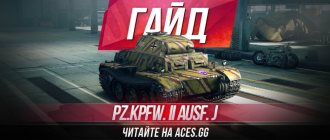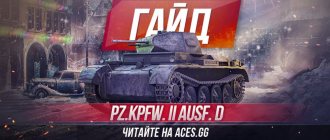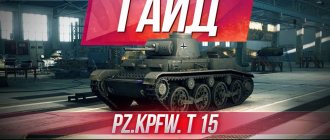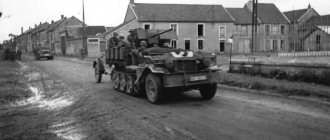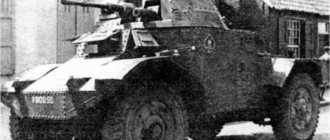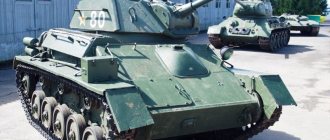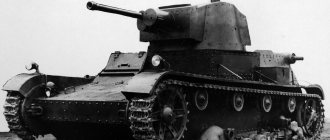Light reconnaissance tank Pz.Kpfw.II Ausf.L Luchs (Germany)
Back in 1938, the German army ordered the development of a light reconnaissance tank with a combat weight of about 9 tons, a 20-mm automatic cannon and armor up to 30 mm thick. Over the next few years, leading developers of armored vehicles created several variants of similar vehicles, which, however, did not reach mass production. The light reconnaissance tank project was brought into service by the troops only by the end of 1942. The production vehicle of the new type was designated Pz.Kpfw.II Ausf.L Luchs. The appearance of a new modification of the Panzerkampfwagen II tank was preceded by a number of interesting events. Let us recall that at the end of the thirties, the Wehrmacht wished to receive a light tank based on the existing Pz.Kpfw.II, capable of performing reconnaissance missions and, if necessary, participating in battles, for which it required appropriate protection and weapons. The first version of such an armored vehicle was the VK 901 tank from MAN and Daimler-Benz. This development was tested, but did not receive customer approval due to insufficient protection characteristics and exceeding the required combat weight by about one and a half tons.
Later, the VK 903 project appeared, which also did not suit the military. Increasing the thickness of the side armor by 5 mm did not provide the desired increase in protection, and also prevented the weight requirements from being met. Subsequently, the development of a light tank weighing up to 12-13 tons, called VK 1301, was approved. This vehicle, like its predecessors, did not go into production. Moreover, one of the main reasons for its abandonment was the noticeable progress of the VK 1303 project, which was being developed at the same time. At the same time, there were some technical problems.
Museum tank Pz.Kpfw.II Ausf.L Luchs from Saumurai Photo Wikimedia Commons
In mid-1940, the Czechoslovak companies BMM and Škoda were involved in the program to create a light reconnaissance tank, which led to a serious increase in competition and some acceleration of work. By the end of 1941, all participants in the program submitted their new equipment for testing. An interesting fact is that the first stage of the competition ended with the victory of a light tank from BMM. However, MAN specialists soon improved their version of the armored vehicle, after which it was able to win the second stage of the program in mid-1942. The MAN tank was now proposed to be mass-produced and used by the troops.
Development of the project with the symbol VK 1303 started at the end of 1940. Using existing experience and developments from previous light tank projects, MAN specialists had to develop their own version of an armored vehicle with the required characteristics. By this time, the customer agreed to raise the maximum combat weight to 13 tons, which should have simplified the creation of the project to a certain extent, and also made it possible to provide acceptable protection. In addition, this made it possible to complete the development of a new tank in a relatively short time, since it became possible to widely use existing components and assemblies without major modifications.
The use of ready-made developments led to the expected results. Externally, the VK 1303 tank should have been minimally different from other equipment created earlier. Certain exterior features of this machine were reminiscent of the VK 901, VK 903 and VK 1303. At the same time, there were some noticeable differences in the design of certain units. Within the framework of the two newest projects VK 1301 and VK 1303, it was planned to implement the same ideas, but it was proposed to achieve the goal in different ways and using different equipment.
Prototype chassis used in early testing. Photo: Aviarmor.net
In the VK 1303 project, it was proposed to use existing developments from previous projects, including those related to hull design and armor protection. To save time and maintain continuity, the new tank had to have a general layout traditional for German armored vehicles of that time. The engine was placed in the stern, the transmission in the front of the hull. The habitable compartments should have been placed between them. It was also planned to use the developed form of the hull, assembled by welding from armor plates of various configurations.
The hull of the VK 1303 tank retained the frontal part characteristic of its predecessors, consisting of three sheets 30 mm thick. The bottom and middle sheets were located at different angles to the vertical, the top one was mounted with a slight tilt back. Behind the frontal part were placed vertical sides 20 mm thick. Feed was made from a similar sheet. The roof and bottom should have a thickness of 13 and 10 mm, respectively. Compared to previous developments, the turret box was expanded due to the use of a new turret. To make more efficient use of the internal space, the rear hull sheet was folded back and formed an additional niche.
It was proposed to install a tower on the roof of the building, similar to that used in previous projects. The tower body consisted of several sheets of different shapes, installed with an inward slope. To improve performance and lighten the structure, the turret had bevels at the front and rear of the sides. Protection of the turret from fire from the front was provided by the forehead and a 30 mm thick mask. It was proposed to make the sides of the tower from sheets with a thickness of 15 mm, and the stern from 20 mm. The top of the tower was covered with a sloping 13-mm roof. An interesting feature of the VK 1303 project was the location of the turret in the center of the hull, and not shifted to the side, as in other modifications of the Pz.Kpfw.II.
Luchs tank diagram. Drawing by M. Baryatinsky “Scouts in battle”
The new tank retained the power plant of its predecessors. The aft engine compartment housed a Maybach HL 66P carburetor engine with a power of 180 hp. The engine was equipped with an electric starter, but could also be started using a manual system. The transmission included a main Mecano dry friction clutch from Fichtel & Sachs, a ZF Aphon SSG48 gearbox with six forward speeds and one reverse, as well as MAN shoe brakes. In the aft compartment of the hull, together with the engine, two fuel tanks with a total capacity of 235 liters were placed.
The chassis for the VK 1303 tank was a further development of the units used in previous projects. At the same time, as in the case of the VK 1301, some design changes took place in order to strengthen the units and compensate for the increased combat weight. The chassis received five road wheels with a diameter of 735 mm on each side. The rollers with rubber tires were equipped with individual torsion bar suspension. In addition, the front and rear pairs of rollers received additional hydraulic shock absorbers. The rollers were mounted in two rows in a checkerboard pattern: three inside and two outside.
Spoke front drive wheels with lantern gearing were again used. Guide wheels with tension mechanisms were placed in the stern. The new project used a 360 mm wide small track, developed for one of the previous reconnaissance tanks.
The armored turret of the tank was supposed to house all the necessary machine gun and cannon weapons. Interestingly, during the design the turret and weapon system underwent some changes. Thus, in the first version of the VK 1303 project, an asymmetrical placement of the weapon installation was envisaged, but later it was decided to place the gun on the longitudinal axis of the turret. This made it possible to improve the ergonomics of the internal volumes of the tower to a certain extent without significant changes to its design.
One of the full prototypes. Photo: Aviarmor.net
The 20-mm KwK 38 automatic cannon, already used on several previous modifications of the Pz.Kpfw.II, was chosen as the main weapon for the new tank. This gun with a 55-caliber barrel could accelerate projectiles to speeds of about 1050 m/s and fire 220 rounds per minute. The most effective armor-piercing ammunition of the gun could penetrate up to 35-40 mm of homogeneous armor from a distance of 100 m. The gun was fed with ammunition using belts placed in metal boxes. Inside the fighting compartment there was a gun ammunition load of 330 shells.
A coaxial MG 34 machine gun of 7.92 mm caliber was mounted in the same installation with the cannon. The machine gun's ammunition capacity is 2250 rounds.
It was proposed to aim the weapon using manual drives, which ensured the rotation of the turret and the raising of the gun mount. With the help of such mechanisms it was possible to fire in any direction with an elevation of the barrels from -9° to +18°. The gun was equipped with a TZF 6/38 sight from Zeiss, which could be used for firing from a cannon and machine gun. In addition, the machine gun was equipped with its own KgzF 2 sight.
Over time, the light tank received additional weapons in the form of two three-barrel smoke grenade launchers. These devices were supposed to be placed in front of the sides of the tower. The purpose of the 90 mm grenade launchers was to provide camouflage in various combat situations.
Interior of the fighting compartment. Photo Pro-tank.ru
The crew of the new tank consisted of four people. The driver and radio operator were to be located in the front control compartment of the hull. There were two hatches in the roof of the control compartment for access to the crew seats. There were four hatches in the frontal plate and sides of the hull to monitor the environment. It was planned to install FuG 12 and FuG Spr “a” radio stations at the radio operator’s workplace. The antenna of one of the stations was placed on the rear of the turret, and the second, a panicle type, was to be mounted in a special cup on the right side of the turret box.
The turret housed the workstations of the commander and gunner, who was also supposed to serve as a loader. It was decided to abandon the use of the commander's cupola, which is why observation was now proposed to be carried out using two periscopes in the hatches. A slit viewing device also appeared on the right side of the tower.
During the VK 1303 project, MAN designers managed to meet the customer's requirements for the dimensions and weight of the machine. The length of the tank was 4.63 m, width - 2.48 m, height - 2.21 m. The combat weight did not exceed 11.8-12 tons. The estimated maximum speed reached 60 km/h, cruising range - 290 km. Such high mobility had to be ensured by the relatively good specific power of the tank: at least 15 hp. per ton.
Pz.Kpfw.II Ausf.L tank at the front. Photo: Aviarmor.net
By mid-1941, the VK 1303 project had reached the stage of testing the prototype chassis. At the MAN plant, a prototype of the vehicle was assembled, which was not equipped with a full-fledged hull and turret. To simplify the design, this vehicle received an empty volume in place of the fighting compartment, which was partially filled with cargo to simulate the weight of the tank. The experimental vehicle also received a windshield and several other parts that are completely uncharacteristic of armored combat vehicles, but make the work of the testers easier.
Comparative tests of several light reconnaissance tanks developed by different companies took place in May-June 1942. These tests showed the clear superiority of the VK 1303 tank over other vehicles. Based on the comparison results, the military made their choice - the army was to receive light tanks from MAN. Other machines had less high characteristics and therefore could not interest the customer.
In mid-1942, the VK 1303 tank was put into service under the designation Pz.Kpfw.II Ausf.L Luchs (“Lynx”). Soon an order for serial construction of equipment appeared. The Wehrmacht ordered the construction and delivery of 800 light tanks of the new model. The production of this equipment was entrusted to MAN and Henschel. In the fall of 1942 (some sources mention the fall of 1943), the first production tanks rolled off the assembly line.
By the end of 1942, a proposal arose to modernize the new tank in order to improve its basic characteristics. Thus, the weapons used caused serious complaints. By this time, the 20-mm KwK 38 automatic cannon had become outdated and had lost the ability to hit massive enemy tanks. In this regard, the development of a new version of the Lynx with enhanced weapons began. In some sources, such a machine is mentioned under the designation VK 1303b.
Museum sample. Photo: Modelwork.pl
The 5 cm KwK 39 L/60 gun of 50 mm caliber was chosen as the main means of increasing firepower. Such a weapon made it possible to solve the problem, but required redesign of the armored vehicle. The existing turret, designed for the KwK 38 gun, could not accommodate the new high-power gun. A new version of the tower was developed, characterized by increased dimensions and, according to some sources, the absence of a roof.
At a certain stage of the project's development, a proposal arose to equip the Pz.Kpfw.II Ausf.L tank with a more powerful engine. Instead of the existing Maybach HL 66P, it was proposed to use a Tatra 103 diesel engine with 220 hp. One of the production tanks underwent such a modification, but the modernization did not advance further. Serial armored vehicles were equipped only with standard carburetor engines.
Despite all efforts, it was not possible to fulfill the order for the construction of eight hundred tanks of a new type. According to various sources, no more than 100-142 Luchs-type vehicles were built before the beginning of 1944. According to some sources, several tanks were rebuilt from experimental VK 1301s, while the remaining vehicles were built from scratch. In total, MAN built no more than 118 tanks, and Henschel produced up to 18 vehicles. In January 1944, production was curtailed. By this time, the contractor factories were loaded with several high-priority orders, which is why they could no longer produce light tanks with ambiguous prospects. As a result, not even a fifth of the original order was completed.
A version of a light tank with reinforced armament, according to various sources, was not realized in metal or did not leave the testing stage. Some sources claim that such an armored vehicle was not even built, while others talk about the assembly of several prototypes. In addition, there is mention of the production of 31 tanks with 50 mm cannons. However, according to most sources, the Lynx with the KwK 39 gun did not go into production.
A tank that has survived to this day, view of the stern. Photo Lesffi.vraiforum.com
There are references to two projects of special equipment based on the new light tank. Based on the existing chassis, it was proposed to build a Bergepanzer Luchs repair and recovery vehicle, suitable for servicing several types of light tanks. In addition, the possibility of creating a Flakpanzer Luchs self-propelled anti-aircraft gun with an original fighting compartment equipped with a 37-mm automatic cannon was considered.
The first production Pz.Kpfw.II Ausf.L tanks entered service in the fall of 1942. It was proposed to distribute reconnaissance vehicles in several units among existing large formations. It was assumed that a new company equipped with Luchs tanks would appear in the reconnaissance battalions of tank divisions. The initial order made it possible to equip a large number of formations with new equipment, but in practice the rearmament was delayed and then reduced.
Due to the halt in the production of new tanks after 100-142 units, only a few formations managed to receive the equipment: the 2nd, 3rd, 4th and 116th tank divisions, the Wehrmacht training division and the 3rd SS Totenkopf tank division. The task of the vehicles transferred to the battalions of these formations was to participate in reconnaissance and supplement the equipment already in service.
According to some reports, some operators of Pz.Kpfw.II Ausf.L tanks were dissatisfied with the characteristics of this equipment. Thus, it is known about homemade reinforcement of armor by installing additional 20-mm sheets on the frontal parts of the hull. Such modification in the conditions of military workshops made it possible to significantly increase the level of protection and survivability of the vehicle on the battlefield.
The museum tank “performs” in front of the audience. Photo Pro-tank.ru
According to most sources, Luchs tanks were actively used for a long time. The latest reports of the massive use of such equipment for intelligence purposes date back to the end of 1944. Moreover, until the summer of 1944, Lynx-type vehicles were used only on the Eastern Front, and after the start of fighting in Western Europe, some of the formations armed with such equipment were transferred to a new theater of military operations. Thus, light reconnaissance tanks, which were in service with several divisions, managed to fight on all European fronts and fight with armored vehicles of several countries of the anti-Hitler coalition.
Due to the specific combination of protection and firepower, which directly affected combat effectiveness and survivability on the battlefield, the Pz.Kpfw.II Ausf.L Luchs light reconnaissance tanks were exposed to serious risks. They could withstand enemy infantry or light tanks, but medium tanks and artillery proved too much of a threat. As a result, reconnaissance units regularly suffered losses. Moreover, by the end of the war, almost all Lynx tanks were disabled, destroyed or captured by the enemy.
Of the 100-142 Luchs tanks built, only a few vehicles have survived to this day, and are now museum exhibits. Tanks of this type are kept in the British Bovington, the French Saumur, the German Münster, the Russian Kubinka and several other museums. This equipment undergoes regular restoration and is in good condition. In addition, some of the machines are still operational and are used in demonstrations.
The project to develop a light reconnaissance tank started in mid-1938, but real results in the form of production equipment of the required type appeared only in the fall of 1942. Such delays in work led to unpleasant consequences for the German army. The 1942 model tank was actually created according to modified technical specifications of the late thirties, which is why it could no longer fully meet the requirements of its time. As a result, no more than one and a half hundred cars were built, after which construction was curtailed due to the lack of noticeable prospects. Thus, the task set by the army was solved, but it happened too late for the full use of the new technology.
Based on materials from: https://aviarmor.net/ https://achtungpanzer.com/ https://pro-tank.ru/ https://armor.kiev.ua/ https://lexikon-der-wehrmacht.de / Chamberlain P., Doyle H. Complete reference book of German tanks and self-propelled guns of the Second World War. – M.: AST: Astrel, 2008. Baryatinsky M. Scouts in force // Modeler-designer. 2001. No. 11. P.32.
Modules
| Penetration (mm) | Damage (HP) | Rapid fire (rounds/min) | Spread (m/100m) | Mixing (c) | Weight, kg) | Price (|) | ||
| I | 2 cm KwK 38 L/55 | 23/46 | 11/11 | 126 | 0.57 | 1.37 | 70 | 1920 |
| I | 3.7 cm KwK 36 L/46.5 | 40/74/18 | 36/36/42 | 26.25 | 0.46 | 1.71 | 100 | 1000 |
| II | 2 cm Flak 38 L/112 | 39/51 | 11/11 | 126 | 0.45 | 1.37 | 110 | 3160 |
| III | 5 cm KwK 38 L/42 | 60/96/25 | 70/70/90 | 23.86 | 0.48 | 2.29 | 700 | 8570 |
| Armor (mm) | Rotation (gr/sec) | Review (m) | Weight, kg) | Price (|) | ||
| III | PzKpfw-IIL-Luchsturm | 30/20/20 | 39.375 | 323.75 | 950 | 1580 |
| IV | PzKpfw-IIL-Gro?turm | 50/30/30 | 26.25 | 332.5 | 2500 | 4700 |
| Power (hp) | Fire probability (%) | Weight, kg) | Price (|) | ||
| III | Maybach HL 62 TR | 140 | 20 | 550 | 4220 |
| IV | Maybach HL 66P | 200 | 20 | 550 | 8650 |
| V | Maybach HL 90 | 360 | 20 | 550 | 16400 |
| Max. load (t) | Turning speed (gr/sec) | Rmin | Weight, kg) | Price (|) | ||
| III | Luchsketten Ausf. A | 12.25 | 35 | B/2 | 3000 | 1840 |
| IV | Luchsketten Ausf. B | 15.85 | 38 | B/2 | 3000 | 4650 |
| Communication range (m) | Weight, kg) | Price (|) | ||
| III | FuG 5 | 310 | 50 | 630 |
| VI | FuG 7 | 415 | 70 | 8160 |
| VII | FuG Spr. 1 | 455 | 150 | 21600 |
Combat use[edit]
Luchs were supposed to enter service with tank reconnaissance companies in accordance with the state K.St.N.1162b, approved on January 10, 1943. Composition: four platoons of 7 Luchs each and one under company control. The staff also included 4 light half-track armored personnel carriers Sd.Kfz.250/1 and 8 half-track tractors (one tow truck Sd.Kfz.9 and 7 Sd.Kfz.2). Luksa units began to enter service with the troops in the fall of 1942. The first to receive new tanks was the 2nd company of the 4th reconnaissance battalion of the 4th tank division. On September 26, 1943, the company was disbanded, and the remaining equipment was sent to the factory for overhaul. Not all tanks returned from it; some were written off. Later, the company was created again, this time as the 1st company of the 9th reconnaissance battalion of the 9th tank division. It reached a state of combat readiness by March 1944. This time it consisted of 25 tanks - 1 headquarters and 6 in each of the 4 platoons. These vehicles did not reach the Eastern Front. Its combat use took place in France in June 1944. The remaining assembled vehicles either later went to the specified units for completion, or were distributed individually to other units. Thus, 5 tanks ended up in the 4th Cavalry Brigade, and one by December 30, 1944 was listed in the Hermann Goering tank division.
One of the few operations in which Pz.Sp.Wg.II participated in truly large numbers was Operation Citadel. During its course, by August 17, 1943, only 5 tanks remained in combat-ready condition in the 2nd tank reconnaissance company. By September 1, out of 29 vehicles in the company, 10 remained in one form or another. The Lukhs were used in these formations until the end of World War II[1]. In some parts, the frontal armor of the tank was reinforced with additional 20 mm armor plates. A similar reinforcement was carried out in the 4th reconnaissance battalion of the 4th tank division[5].
